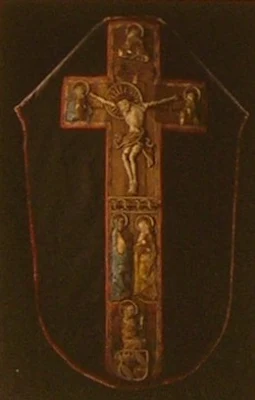
Obviously the highlight of this chasuble is the dorsal cross in relief embroidery, of which you can see a detail here (like all pictures, click to enlarge and see the incredible craftsmanship):

For those not familiar with this technique, the plastic effect was achieved by first embroidering the figures on linen, then back-filling them with cloth bolsters and only then mounting them upon the supporting cloth, in this case the Cross of gold thread couched with a red thread forming a trellis. It has to be said that compared with the incredible work that went into these pieces, even the most expensive modern vestments are quite plain.
Another, rather splendid example, where however only the dorsal cross itself with an identical iconographic programme (Mary on John beneath the Crucified, Mary Magdalene kneeling at the foot, Peter and Paul in the arms of the Cross, and above God Father) as the one above survives, is this, from the late 15th/early 16th century:

As this picture taken by me in the dark of the museum is unfortunately somewhat shaky, here is a better view from the catalogue:

Note the Angels who collect the Precious Blood flowing from the wounds in chalices - stressing the sacramental identity of the Sacrifice of Calvary and its renewal in the Sacrifice of the Mass.
And now for one of if not the highlight of the vestments of Halberstadt - the most precious extant mitre of the time around 1300 north of the alps:

Again my picture is rather shaky, but the catalogue provides some spectacular close-ups:

The mitre is extremely richly embroidered with white sweetwater pearls, red coral, and green and blue glass pearls. In place of a braid, gold plating is employed.

In the circulus, there are four depictions of animals: a lion animating its stillborn cubs by its breath, a phoenix rising from the ash, an eagle rising to the sun with its young, and pelican feeding its young with its heart's blood - symbols of Christ's sacrificial death and resurrection. Here is the phoenix:

